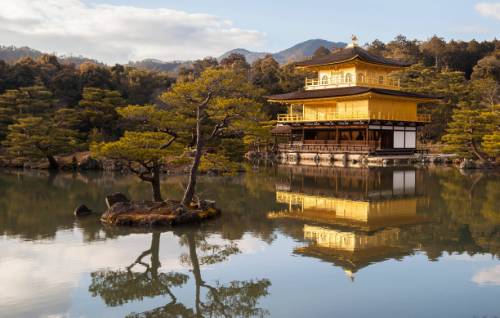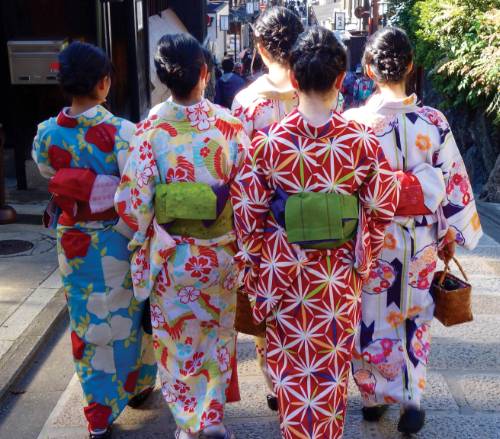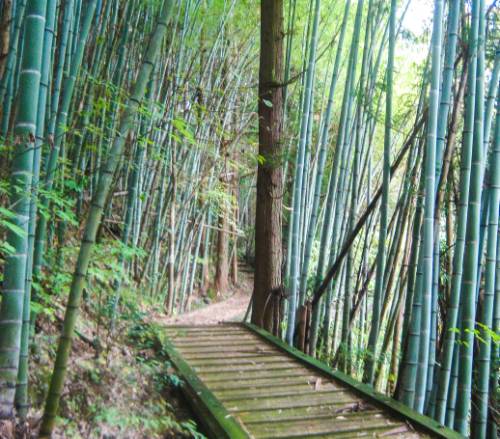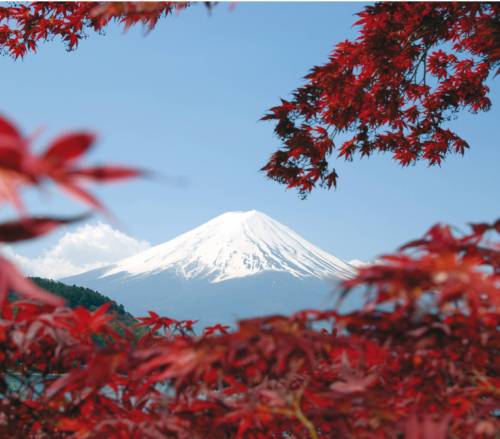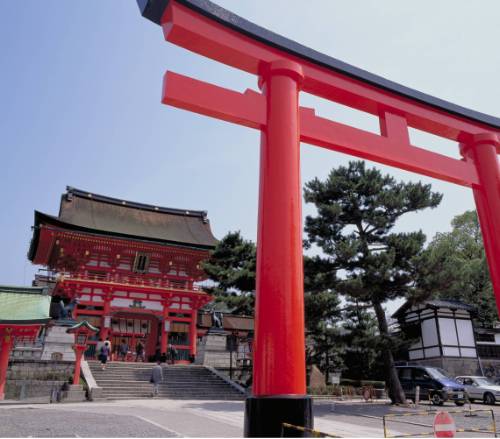Backroads of Japan
Backroads of Japan
$5860
Tour Overview
Embark on an unforgettable journey through the Backroads of Japan, where tradition meets breathtaking landscapes. Begin your adventure in the vibrant city of Tokyo, exploring its bustling streets and iconic landmarks. Marvel at the majestic Mt. Fuji and its serene five lakes, before hiking the historic Nakasendo Way through charming postal towns and lush forests. Discover the cultural treasures of Kyoto, from the enchanting geisha district to the stunning Golden Pavilion. Savor authentic Japanese cuisine with included meals and immerse yourself in the lively markets of Osaka. Experience the tranquility of ancient pilgrim trails leading to the sacred peak of Omine in Nara. With comfortable accommodations ranging from traditional ryokans to modern hotels, and guided by an expert bilingual guide, this tour offers a perfect blend of adventure, culture, and relaxation. ...more ...less
Highlights
Itinerary
Day 1 : Arrive Tokyo
Location: Tokyo
Accommodation Name: Sunroute Asakusa or similar
On arrival you will need to make your own way to the group hotel. We will have an important tour briefing at approximately 6.00pm, so please check with reception for the exact time and location. Following the meeting your guide will take you to a local restaurant (meal is at own cost) followed by an optional night tour, typically to Shinjuku and/or Shibuya, to sample Tokyo’s neon lights (transport is at own cost). First impressions of the industrial outer suburbs of Tokyo - a seemingly endless display of concrete and elevated highways - give little clue about the natural pleasures of coming days. Tokyo is a hive of activity, with a mind-boggling range of shops, restaurants and businesses that make it one of the world’s most energetic cities. The train is quite an experience, particularly during peak hours where the standard practice is to squeeze as many people possible into each carriage! And Japan does not need to be expensive. The following is a small suggestion for places that you can enjoy for free - the Imperial Palace East Garden; Ryogoku Fireworks Museum; Sumo Museum and the Beer Museum Ebisu.
Overnight: Sunroute Asakusa or similar ...more ...less
Day 2 : Explore Tokyo, to Fuji Five Lakes
Location: Tokyo
Accommodation Name: Route Inn Kawaguchiko or similar
Meals Included: Breakfast
After breakfast we head off to explore a small part of this incredible city. We begin with a subway trip to the Tsukiji Outer Market'. From the market we continue to Tokyo's downtown area near Sumida River where we visit Sensoji Temple - the oldest temple in Tokyo, and walk through Nakamise shopping street which is lined with stores from the Edo period (1603 - 1867). In the early afternoon we will collect our bags before we travel by train to the bus station for our journey to Lake Kawaguchi at the base of Mount Fuji (approx 3 hours). Lake Kawaguchi is located in the centre of Fujigoko (Fuji Five Lakes) and is famous for its spectacular views of Mt Fuji from its northern shore. If we are lucky we may get to see the mountain in its full glory, however Mt Fuji is notoriously shy, and is prone to swift changing winds and temperature fluctuations so there is no guarantee that it will show itself through the ever-changing cloud cover that often shroud it.
Overnight: Route Inn Kawaguchiko or similar
Day 3 : Hiking in the Kawaguchiko area
Location: Kawaguchiko
Accommodation Name: Route Inn Kawaguchiko or similar
Meals Included: Breakfast
After breakfast, we will head out for today’s guided hike. Your guide will select the best trail for the group. This might be a trail at the base of Mount Fuji or climbing one of the lower mountains in the area. Ideally, Mount Fuji will show itself (weather permitting) for excellent photo opportunities of Japan’s most sacred mountain. Mt Fuji stands at a height of 3776m and the average temperature at the summit is between 4.8°- 5.8° C (40.5° - 42.5° F) during the summer months of July and August. The official season for climbers is July and August and it takes about 6 hours from the 5th station to the summit.Considered a sacred mountain during the Edo period, Mt Fuji is still climbed by worshipers. The afternoon is free time (non guided) but your guide will help advise you on best places to visit and how to get there. There are many local attractions to visit including hot springs, temples and shrines, quirky museums such as the Kawaguchiko Kinohana Art Museum or the Kawaguchiko Music Forest Museum. Alternatively you may wish to hike around the shores of one of the smaller nearby lakes or rent a bicycle to venture further.
Hiking: ~4.5km (1½hrs) or ~12km (4hrs) dependent on group ability and weather conditions.
Overnight: Route Inn Kawaguchiko or similar
Day 4 : Travel to Kiso Valley
Location: Kiso Valley
Accommodation Name: Hanaya ryokan or similar
Meals Included: Dinner
A series of train journeys through the morning will get us to Tsumago, one of the historic mountain-bound towns of Kiso, an historic trade route through a thick-forested valley. Our base in Tsumago, is a town preserved more or less as it stood in the 18th century.
Kiso Valley, in the southwestern part of Nagano, is the most mountainous prefecture located in Central Japan. Surrounded by the Central Alps to the east and the North Alps to the west, the deep valley formed by the Kiso River is filled with the fragrance of woodland trees.
After alighting at Nagiso train station, we'll experience our first walk on the Nakasendo trail towards Tsumago. (4 km, about 1 hour walk) We'll spend time exploring Tsumago town before heading our way to our accommodation for the night (about a 20 min walk from Tsumago). The old Nakasendo Road was completed in the Edo period as a trunk road between Kyoto and Tokyo. The day ends at a traditional-style inn where you will enjoy a feast of seasonal dishes.
Note: This morning you will need to pack a small overnight bag. Your main luggage will be sent to the accommodation in Kyoto.
Overnight: Hanaya ryokan or similar
Day 5 : Old Nakasendo Highway, train to Kyoto
Location: Kyoto
Accommodation Name: Resol Kyoto Kawaramachi Sanjo Hotel or similar
We spend the day hiking along the ancient Nakasendo Way which connects the old capital Kyoto, to the new capital, Tokyo. Magome and Tsumago, the southernmost post towns have single main streets that are lined with shops selling traditional foods and local crafted goods, chiefly wood and lacquer. They are an architectural fantasy in timber. In the afternoon we travel by train, descending through the Central Alps to Nagoya, where we will change to the Shinkansen (bullet train) bound for Kyoto. With temples and teahouses, shrines and geisha, Kyoto is Japan’s cultural heart. From the end of the Nara Period (794) Kyoto has functioned as the crossroads of Japanese history. Kyoto, which was Japan’s capital for more than 1000 years, is a veritable open air museum. All over the city you can find countless shrines, temples, palaces and other historical sites which are best discovered by foot. The district was built to accommodate the needs of travellers and visitors to the shrine. It eventually evolved to become one of the most exclusive and well-known geisha districts in all of Japan.
Hiking: ~16km (5.5hrs)
Overnight: Resol Kyoto Kawaramachi Sanjo Hotel or similar
Day 6 : Visiting Kyoto’s Temples
Location: Kyoto
Accommodation Name: Resol Kyoto Kawaramachi Sanjo Hotel or similar
There is a great deal to see by day in Kyoto, and the content of our days here may be re-shuffled to optimise weather conditions and local events from the busy communal calendar of festivities.
The highlights of today’s guided tour will be visiting at least two of the Kyoto’s many Buddhist temples. Your guide will suggest temples, possibly some of the temples tucked into the range of hills containing the city on its east side. The day will also include a walk though the city centre. By evening you will have enjoyed an orientation of this city.
Overnight: Resol Kyoto Kawaramachi Sanjo Hotel or similar
Day 7 : Climb Mount Daimonji
Location: Kyoto
Accommodation Name: Resol Kyoto Kawaramachi Sanjo Hotel or similar
The low lying plains and river scenery of the Kyoto Basin have been the stage for some of the most edifying and poignant episodes in Japanese lore. A guided climb to the lookout atop the mountain known colloquially as Daimonji will give us a bird’s eye view of history. The hike up the mountain takes about 60 minutes and is well worth the effort. Part of the East Mountains, Daimonji-yama offers the most accessible and expansive view of the city. It is so high that on a clear day the skyscrapers of distant Osaka can be seen. For those who prefer to stay at base level, there is the option of walking along the Philosophers’ Path by yourself.
The rest of the day will be occupied with sightseeing based on personal preferences as not everyone will have the same list of must-do activities. While this is not guided, your leader will be pleased to assist you and point you directly to the sites that will give you the most pleasure. Why not visit Heian Shrine built to commemorate Kyoto’s founding, Kinkakuji (Golden Pavilion), or even try your hand at a cooking class, join a traditional tea ceremony or dress like a Geisha (please notify your guide beforehand as these activities need to be pre-booked).
Hiking: ~3km (2hrs)
Overnight: Resol Kyoto Kawaramachi Sanjo Hotel or similar
Day 8 : In Kyoto free exploration
Location: Kyoto
Accommodation Name: Resol Kyoto Kawaramachi Sanjo Hotel or similar
Essentially a free day for you (non guided), today you will have the opportunity to explore this fascinating city at your own pace. You may want to catch up on some shopping, write some postcards, or just reflect on the experience of recent days by the bank of the Kamo River. By this stage you may be feeling the urge to inhale the meditative atmosphere of Kyoto’s Buddhist temples and Shinto shrines in the privacy of your own thoughts or explore nearby Nara (day-trip out of Kyoto).
About 42km south of Kyoto, Nara was the old capital of Japan (710-784) and was the cradle of arts, crafts and literature. Buddhism first flourished here under the strong patronage of successive Emperors and walking through the quiet streets is like walking through the pages of history.
Overnight: Resol Kyoto Kawaramachi Sanjo Hotel or similar
Day 9 : Hike & Train to Asuka
Location: Asuka
Accommodation Name: Minshuku Wakimoto or Route Inn Sakurai
Meals Included: Breakfast
Following an early breakfast we board our train to the Nara Basin (our main luggage will be forwarded to Dorogawa). Gradually leaving suburbia behind, we can now look forward to the next couple of days of our walking adventure. In the 6th Century the first mainland Asian-style capitals of Japan emerged here, and between them ran the country’s oldest transit route - the Yamanobe Road. In the subsequent centuries the power centre moved elsewhere and the area simply de-urbanised into a rural zone of small-hold agriculture. Most of today will be spent weaving through farms, rice paddies and bamboo groves at the foot of sacred Mount Miwa. In the late afternoon we will travel by public transport to the next valley to the south. We end the day in Asuka, one of the most romantic sites in Japanese history.
Asuka is a small region in Nara prefecture (about 25 kilometers south of Nara City) which had a pivotal role in Japanese history. Lending its name to the Asuka Period (538-710), the region was the site of Japan's first capitals from where the early Japanese national character emerged. A few monuments of that period remain, but the area is now mostly fields and rural villages.
Note: this morning you will need to pack a small bag for our walk for the next 2 nights. Your main luggage will be sent to the accommodation in Dorogawa (day 11).
Hiking: ~16km (5hrs)
Overnight: Minshuku Wakimoto or Route Inn Sakurai
Day 10 : Hike Japan's oldest path in Asuka
Location: Asuka
Accommodation Name: Kam Kam ryokan or similar
Meals Included: Dinner
In the morning we will hike through the historic Asuka region, along trails connecting mysterious domed tomb mounds and several of Japan’s oldest temples.
The remnants of the Asuka Period that remain today are mostly limited to stone monuments and archaeological excavations. Burial tombs such as the Ishibutai Tomb or the Takamatsuzuka Tomb are preserved in their original state, while artefacts and recreations are on display at local museums like the Asuka Museum, or the Complex of Manyo Culture. In the afternoon we will transfer by train and shuttle bus to mountainous Yoshino. For over a millennium Yoshina was a major way station along the pilgrim’s trail into Omine (Great Peak) and since 2004 it has enjoyed UNESCO World Heritage status. If time allows, you have a chance to explore the town including Kinpusenji Temple. The base of Japan’s mountain ascetic monks. A dinner feast will fortify us for tomorrow’s hike.
Walk: ~6km (3hrs)
Overnight: Kam Kam ryokan or similar
Day 11 : Hike & Bus to Dorogawa
Location: Dorogawa
Accommodation Name: Hanaya Tokubei ryokan or similar
Meals Included: Dinner
The trail we follow out of Yoshino today weaves through mountains thick with cherry trees, and as we climb higher these mix with fir, pine, and cedar. We will stop to rest at wayside shrines and panoramic mountain passes as we follow a famous pilgrim trail to Omine. From here the scenery changes as we pass through farmlands on our way to Kurotaki before travelling by bus to Dorogawa.
Dorogawa is a secluded area famous for its sweet spring water and traditional herb and fungus medicines. The village is beautiful with interesting scenic points such as Ryusenji Temple with its bright red maple trees and a waterfall to where pilgrims cleanse before visiting the sacred mountain of Omine.
Our accommodation in Dorogawa boasts an onsen, a naturally heated thermal bath, a great way to relax after our walk.
Hiking: ~9km (4hrs)
Overnight: Hanaya Tokubei ryokan or similar
Day 12 : Hiking around Dorogawa
Location: Dorogawa
Accommodation Name: Hanaya Tokubei ryokan or similar
Today we explore the riverside trails and mountain passes surrounding the village of Dorogawa. Your tour leader will choose a route to walk depending on the weather conditions and season and you are welcome to join him or her, or explore on your own. For those wishing simply to spend the day relaxing, there is the luxury of observing the slow pace of the day in a country town.
Overnight: Hanaya Tokubei ryokan or similar
Day 13 : Mitarai Gorge, travel to Osaka
Location: Osaka
Accommodation Name: Shin-Osaka Esaka Tokyu REI Hotel or similar
Meals Included: Lunch
Following a river this picturesque walk through Mitarai gorge takes us up some
steep stairs and across a few suspension bridges. During early summer the gorge is a mass of bright green leaves which change to various shades of red and yellow with the on set of autumn. Arriving at the junction of Kawai, we have a bento box lunch and then take the bus to Shimoichiguchi station then on to Osaka city. The Kansai metropolitan area, which includes Osaka, has a population that exceeds 20 million, making it one of the largest metropolises in the world. The city of Osaka was first incorporated in 1889 and has become known as the food capital of the world and this port city has had a history of a flourishing economy in part due to trade and travel made possible by its sea and river routes. On arrival at our hotel in Osaka we have time to freshen up before a guided orientation of this exciting city. Osaka can boast some of the most exuberant nightlife in Japan - a walk through the Dotonbori neon light area certainly won’t disappoint.
Note: this morning you will need to pack a day bag. Your main luggage will be sent to the accommodation in Osaka.
Hiking: ~7.5km (3hrs)
Overnight: Shin-Osaka Esaka Tokyu REI Hotel or similar
Day 14 : In Osaka
Location: Osaka
Accommodation Name: Shin-Osaka Esaka Tokyu REI Hotel or similar
Meals Included: Dinner
This morning we will explore some of the sights in Osaka’s Namba area, for example Kuromon market - a market for fish, fruit, vegetables and other foods which has been open since the mid-Taisho period (1912-1926) – or Sennichimae Doguya-Suji, a narrow street with many shops dealing in equipment and utensils used in restaurant and coffee shops. Restaurant owners come here to buy plastic models of dishes used to display their menus in the window. These miniature food imitations are a great souvenir. The afternoon is free time (not guided) to discover Osaka on your own. There is so much to see and do in this city, for example the Museum of Oriental Ceramics, with its extensive collection of Korean and Japanese ceramics, or the Floating Garden Observatory. If you have any special interests your guide will be able to give you recommendations. This evening we will meet for a final farewell dinner to celebrate the end of a fabulous trip.
Overnight: Shin-Osaka Esaka Tokyu REI Hotel or similar
Day 15 : In Osaka, trip concludes
Location: Osaka
Meals Included: Breakfast
The trip concludes today after breakfast. For those travelling to the Kansai International Airport the journey takes approximately 90mins. From Osaka to Tokyo Narita International Airport, takes the best part of 5 hours.
What's Included
-
14 breakfasts, 3 lunches and 8 dinners
The tour includes 14 breakfasts, 3 lunches, and 8 dinners.
-
Comfortable accommodation on twin share basis
Accommodation is provided on a twin share basis.
-
Traditional 'ryokan' inns
Experience staying in traditional 'ryokan' inns.
What's Not Included
-
International airfare, visa and travel insurance (compulsory)
International airfare, visa, and travel insurance are not included and are compulsory.
-
Meals and beverages not indicated in the program
Meals and beverages not indicated in the program are not included.
-
Items of a personal nature such as laundry, phone calls, alcohol etc
Items of a personal nature such as laundry, phone calls, and alcohol are not included.
-
Arrival and departure transfers
Arrival and departure transfers are not included.
What You Carry
In your daypack you will need to carry extra warm clothing (depending on the altitude, location and weather), a rainjacket, water bottle, camera, valuables and personal items such as sunscreen, lip-eze etc.Accommodation
Experience a blend of traditional and modern Japanese accommodation with 9 nights in hotels and family-run inns. Enjoy the unique atmosphere of ryokans, with futon bedding on tatami floors, communal baths, and the option for private rooms when available. Double rooms are smaller, and hot showers are typically available in the evenings.Grading
* Suggested preparation: 45 minutes of aerobic type exercise, three to five times a week for the three months leading up to your trip. Hill walking with a pack in variable weather conditions or road cycling is also recommended depending upon the activity you plan to undertake.
Mode of Transport
Travel through Japan using public trains, buses, and taxis, offering a convenient and authentic way to explore the country. Luggage transfers are included as per the itinerary, ensuring a hassle-free journey as you move between destinations.Check out our Q&As
-
What type of accommodation can I expect during the tour?
The tour includes 9 nights of accommodation, with stays in atmospheric, family-run inns in the countryside and comfortable western-style hotels in major cities. Traditional Japanese 'ryokan' inns are also part of the experience, where you may sleep on 'futon' bedding laid out on tatami floors. In the mountains, groups may sleep together in the same room, but privacy can be arranged with sliding partitions or by booking two-person rooms when available. ...more ...less
-
Are there any specific cultural experiences included in the tour?
Yes, the tour includes several cultural experiences such as visiting the geisha district in Kyoto, exploring traditional markets in Osaka, and staying in traditional 'ryokan' inns. You will also have the opportunity to participate in activities like a traditional tea ceremony or dressing like a Geisha, although these need to be pre-booked. ...more ...less
-
What kind of meals are included in the tour?
The tour includes 14 breakfasts, 3 lunches, and 8 dinners. Many of these meals will allow you to savor Japanese delicacies.
-
What should I pack for the hiking portions of the tour?
For the hiking portions, you should pack extra warm clothing depending on the altitude, location, and weather, a rain jacket, a water bottle, a camera, valuables, and personal items such as sunscreen and lip balm.
-
What is the level of physical fitness required for this tour?
The tour involves trekking for up to 6 or 7 hours a day at a steady pace, with some sections involving steep inclines and descents. A good level of fitness and health is required. It is recommended to prepare with 45 minutes of aerobic exercise, three to five times a week, for the three months leading up to the trip. ...more ...less
-
Will there be opportunities to interact with locals during the tour?
Yes, there will be opportunities to interact with locals, especially during communal bathing experiences in traditional inns and while exploring local markets and towns.
-
Is there any free time during the tour for personal exploration?
Yes, there are several opportunities for personal exploration, such as free afternoons in the Kawaguchiko area, Kyoto, and Osaka, where you can explore at your own pace or follow your interests.
-
Who will be my travelling companions on the tour?
We have offices on three continents which means your travelling companions will be just that – international and wonderfully eclectic. Part of small group travel means that although travellers come from various locations and backgrounds, you will be travelling with like-minded companions who, like you, are keen to share the experience and forge lifelong friendships.
-
What about environmental impact?
We believe that adventure travel revolves around establishing a strong relationship with the people and environments in which we operate. Our responsible travel policies have been carefully developed to ensure that we minimise the impact of our presence and help to protect the regions we visit while contributing positively to the local community.
-
What should I pack?
Your pre-departure documents include a detailed packing list with items that you need to bring. While most of the equipment for daily activities is included in your tour cost, some items like helmets and hiking boots are best brought from home. The pre-departure documents also include information on layering and recommended brands for various items to ensure you are fully prepared for your trip.
-
Do you operate a “single share” option and how does it work?
Yes. World Expeditions does not require single travellers to pay a surcharge for travelling alone on the vast majority of our trips. Our holidays are primarily on a twin share basis, so if you are joining the group as a solo traveller, we will match you with someone of your own gender. The choice is yours however; if you prefer not to share, we do offer single supplements for private occupancy.
-
Are tips included in my trip price?
Tips are not included in the tour cost. Tipping is a personal thing, do not worry about how much, or when, to tip. Tipping guidelines are provided for certain destinations in our pre departure information upon booking, however the best advice will be provided by your tour leader.
-
Am I suited to small-group travel?
We recognise that many of our travellers have not been on a ‘group trip’ before. Yet what our departures provide is both structure and flexibility, allowing you plenty of freedom within the framework of the itinerary. You’ll find that with our maximum group size at 16, you’ll travel in a minimal impact style with a great group of like-minded travellers.
-
Can you advise which vaccinations are recommended?
While our pre-departure kit provides information on vaccinations, we suggest that you consult your doctor, local government inoculation centre or a travel medical specialist in order to get the most current advice regarding vaccination requirements.
Reviews from travellers on this tour
1 Select your preferred date
Book with Confidence
-
Transfer as credit for future tours
World Expeditions allows you to transfer existing payments to a future tour to avoid cancellation fees if you can't travel and inform world expeditions, 70 days before departure.
-
Low Deposit
World Expeditions requires a minimum deposit of 400 GBP per person or the full booking value, whichever is less, with the final balance not due until 70 days before departure.
-
Cancellation Policy
We don't charge a cancellation fee, here is a summary of world expeditions charges.
Up to 70 days before tour starts: Forfeit 100% of deposit.
At 69 days before tour starts: Forfeit 50% of booking price.
At 35 days before tour starts: Forfeit 100% of booking price.
Backroads of Japan
15 Days Starting in Tokyo, Japan and ending in Osaka, Japan
Visiting: Tokyo, Kawaguchiko, Kiso Valley, Kyoto, Asuka, Dorogawa, Osaka
Tour operator:
Tour code:
BOJ
Guide Type:
Fully Guided
Group size:
4 - 14
Tour operated in:
EnglishTrip Styles:
Interests:
Cultural, Foodie and Wine Tours, Gardens & Nature Tours, History
